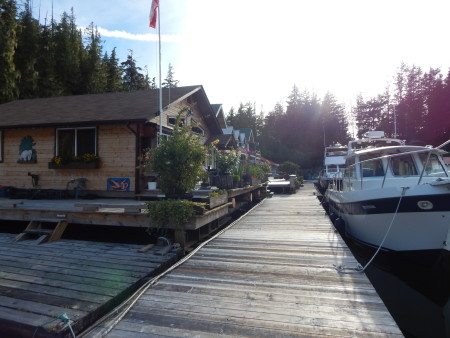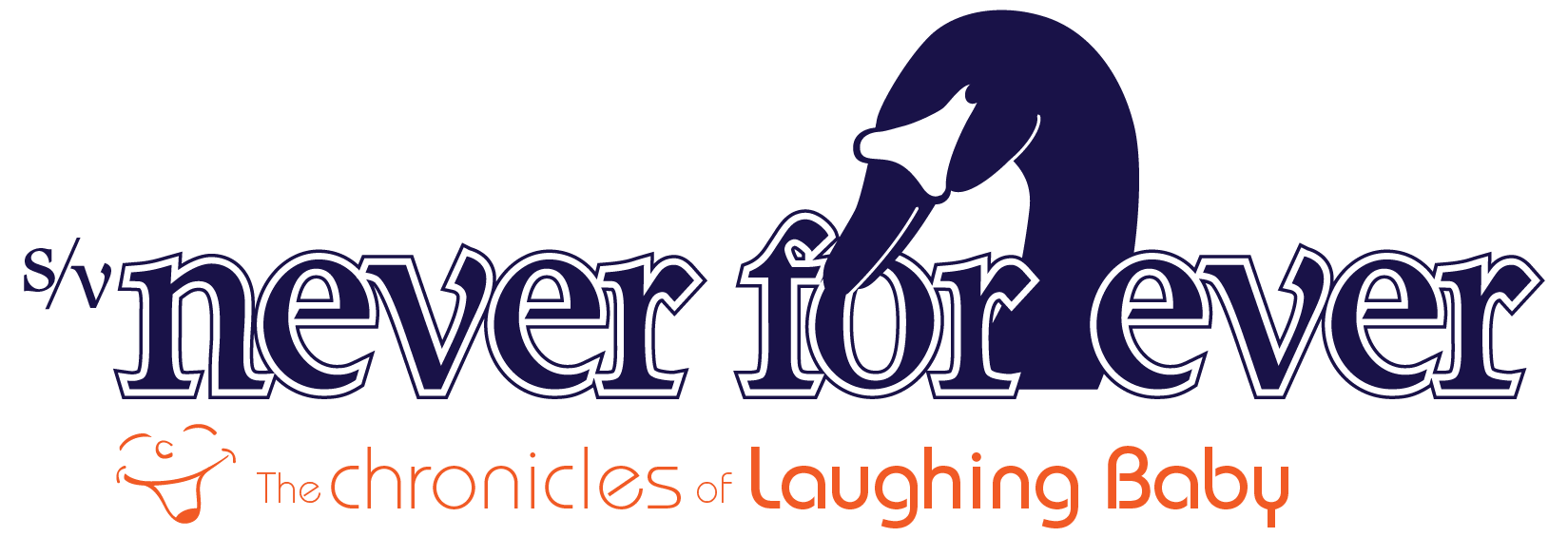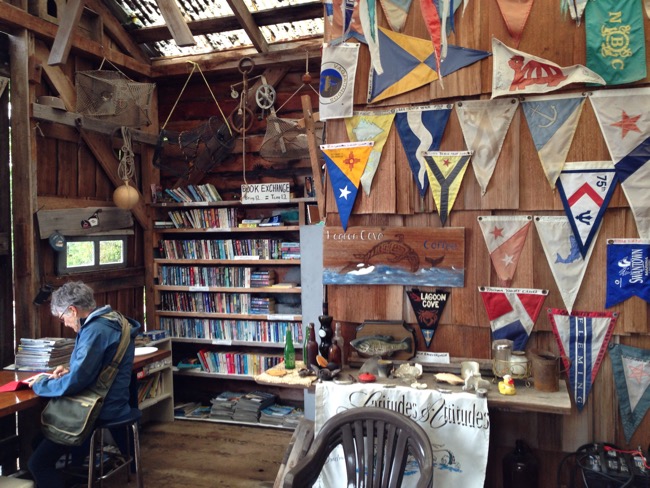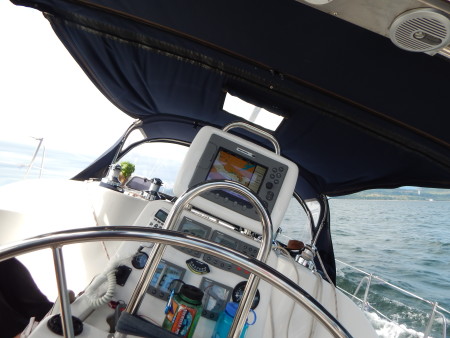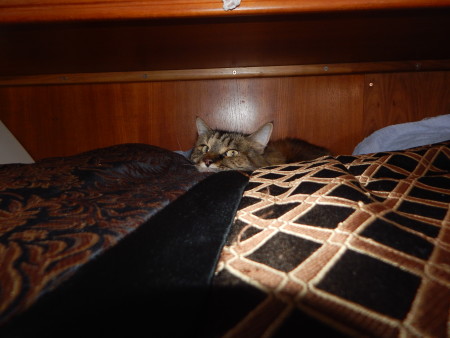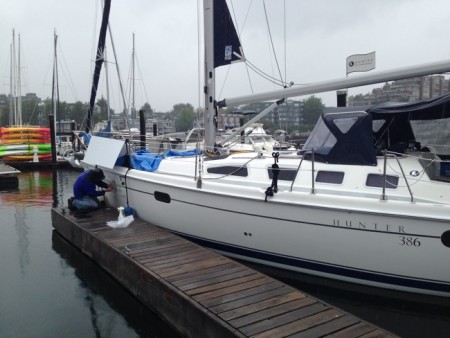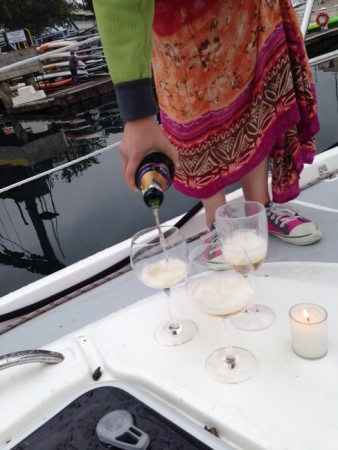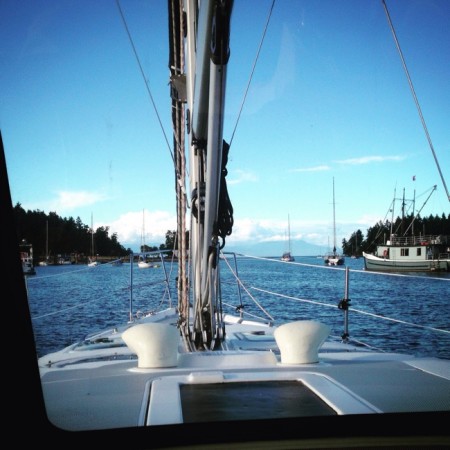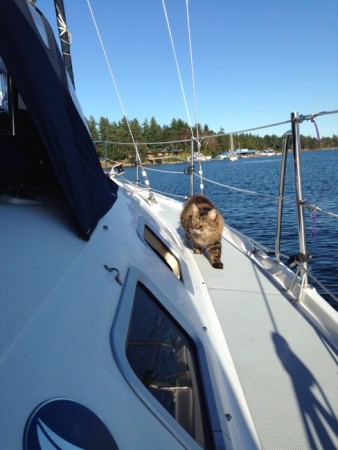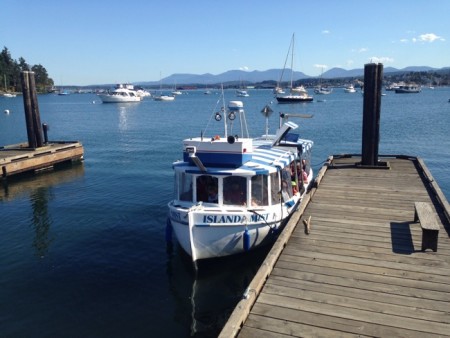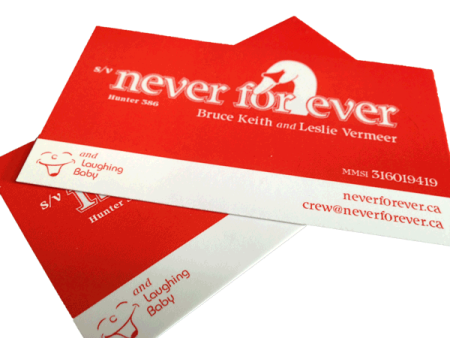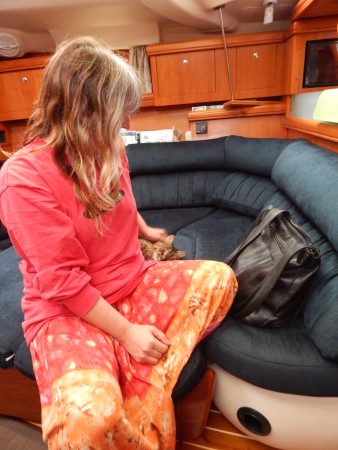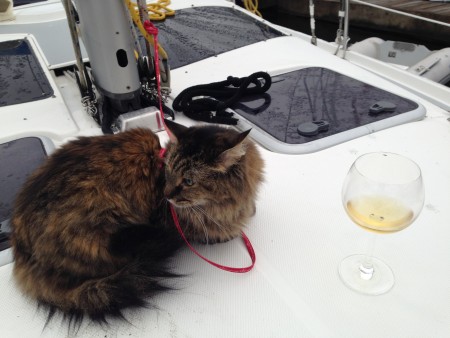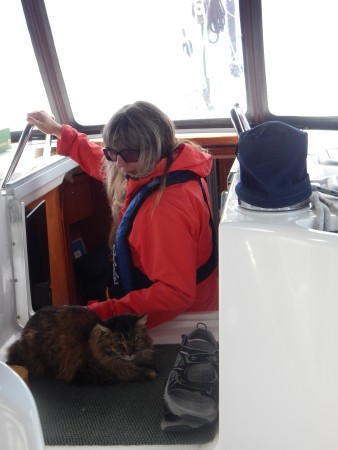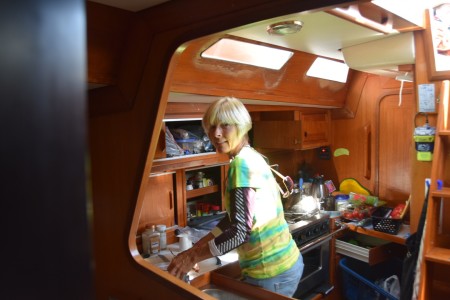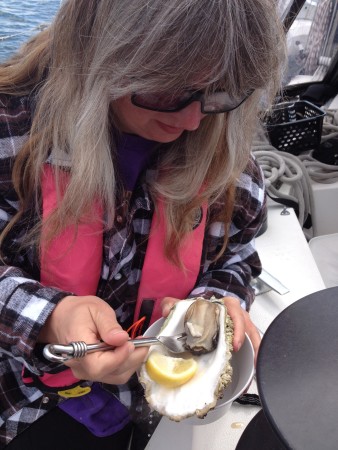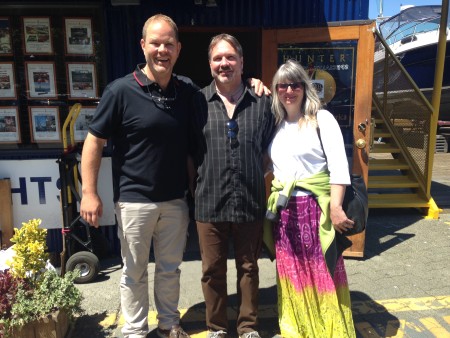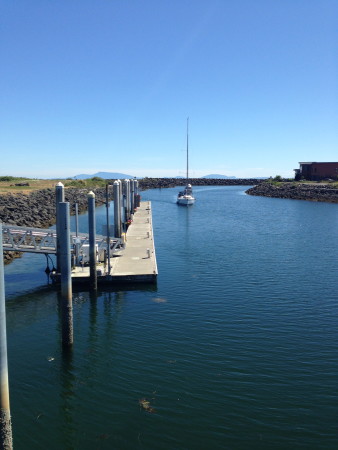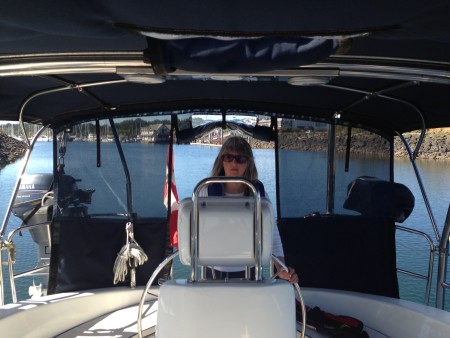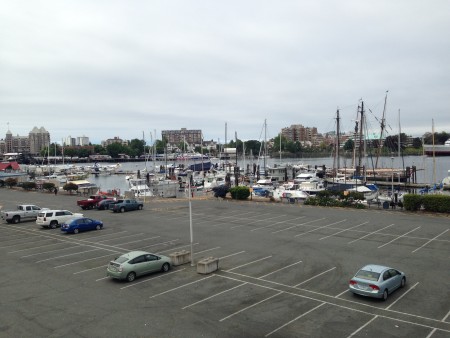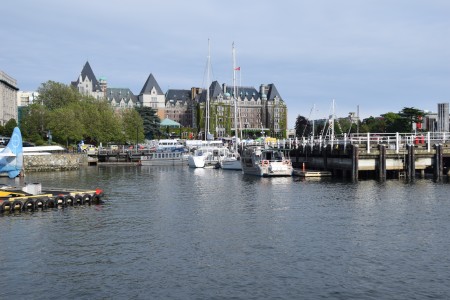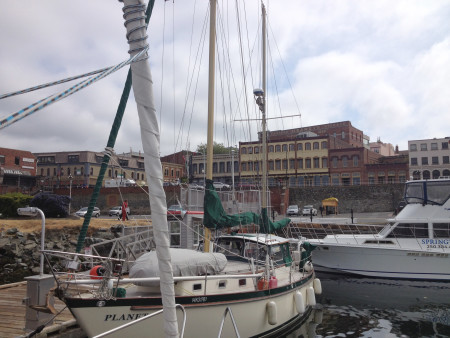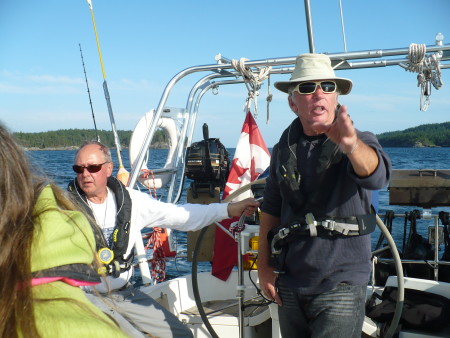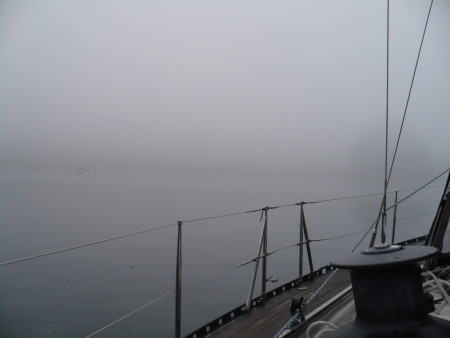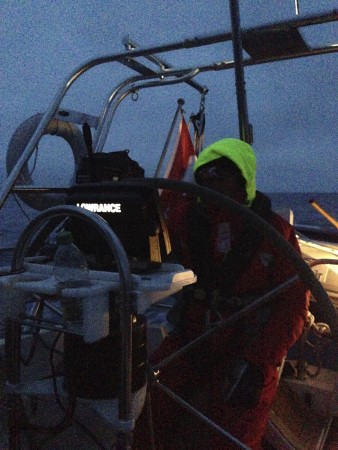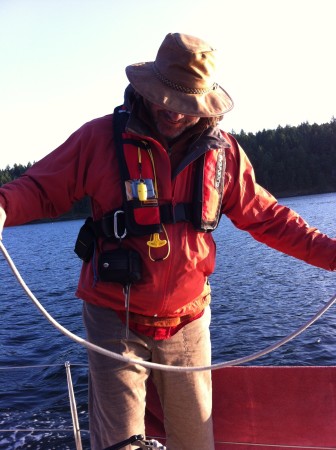Finally in possession of our boat, we had a date on Thetis Island to attend the 2015 Hunter Rendezvous at Telegraph Cove. This 4 day event is hosted by the broker we bought our boat from, Specialty Yachts. For those of you not “in the know,” a rendezvous is a bit like a car meet where owners of certain brands of boats gather to hang out in one place. This affords everyone an opportunity to snoop on one another’s boats, learn new things and generally make the acquaintance of like-minded people.
This year’s Hunter Rendezvous consisted of 85 boats and well over 200 people. The boats ranged from some smaller ones in the high 20-foot range to a few 50’s. There were a few brand new boats to tour and the oldest I saw was from the mid-80s. Suffice it to say there were a lot of boats and we got to wander through a few.
Back at the Beginning
We cast off at Poet’s Cove after filling the fuel tank and headed north. The plan was to grab some supplies at Chemainus and then scoot over to Thetis Island a day early to avoid the potential embarrassment of having to dock a new-to-me boat in front of a crowd.
The wind had shifted (of course) and we were still going pretty much straight into it. So we motored along and played with as much of the boat’s features as possible. This meant mostly running out the foresail and main every time the wind shifted and zooming in and out the chart plotter.
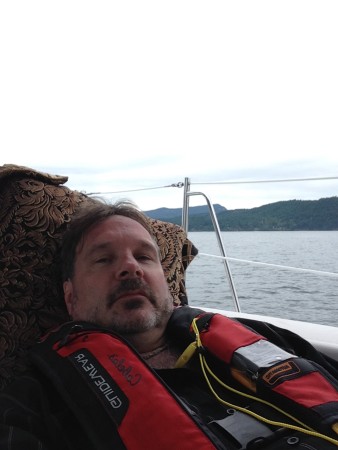
Eventually we turned westerly between Kuper Island and the northern tip of Saltspring and managed to sail for 5 whole minutes. Then we called ahead to Harmon, who is the wharfinger at Chemainus to see if he had room for an hour or so. He said he could probably fit us in but was expecting a big 60-footer so we might be pressed for time.
In the end we tied up on the outside by the ferry and trooped up the hill to 49th Parallel grocery. Unfortunately it seems that since we were here two years ago they had built another location more in the center of town and the remnants were more like a bad cross between a 7-11 and a Home Hardware. Pickings were slim and we were mindful of Harmon’s time frame so did the best we could and headed back to the dock.
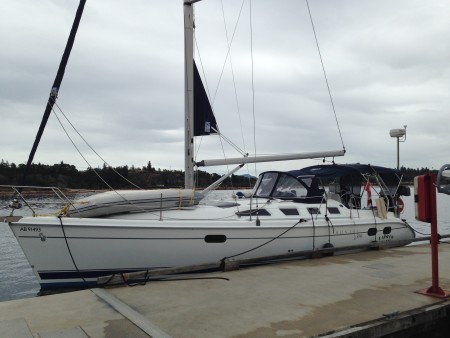
We stopped to chat about the sad state of grocery affairs with Harmon on the way down the finger. He was actually a bit worried. Chemainus is a popular stop for resupply with boats being able to stop for 20 minutes or so and grab groceries. Now they were going to have to go into town and that 20 minutes was likely to stretch to an hour or more. He didn’t think he could reasonably let people tie up for that long.
But since his big yacht was still MIA he let us dump our groceries and head back into town for some beer and wine. In case you haven’t figured it out, Harmon is a great guy.
Hunter Rendezvous 2015
A short motor across Stuart Channel and we were backing into a berth at the nearly empty Telegraph Harbour Marina. Being early snagged us a coveted stern-in spot on the main dock. It also meant we were there for the duration because by the time the weekend was i full swing there were boats crammed in like sardines. And as a bonus we got some Hunter flags to run up our topping lift for the duration.
Then it was chore time. I unshipped the dinghy and filled her up with air. There is a slow leak somewhere, but a half an hour with soapy water failed to reveal its location. We also dismantled the BBQ and started scraping and degreasing. It had been put away last fall without a cleaning and was mouldy and disgusting. We made a mess and ruined a couple of washclothes and sponges, but finally it was spic and span.
Next up was a start on removing the lettering from the boat. I still harboured hopes of renaming her on this trip, but first the old name had to go. I started on the transom and the city name came off pretty easily, so I optimistically moved on to the name on the stern.

Removing vinyl
Before leaving Edmonton I had done some research. Seems the easiest way to remove vinyl is with heat. But since I knew I wouldn’t have access to a heat gun or even a blow dryer I needed another solution. What I came up with was this: Vinyl-Off. This was a spray-on product that supposedly penetrates the vinyl and the glue and allows you to peel off the letters easily. Well it worked pretty good on the transom’s city name but when I tried it on the boat name it didn’t work as well. And when moved next to the side of the boat things got harder. I don’t know if this was older vinyl or perhaps the location had made it more vulnerable to the harsh elements but the going suddenly got bad. The vinyl came off in bits and the glue remained stuck to the gelcoat.
I also got frustrated and started using more of the Vinyl-Off (specifically advised against by the instructions) and the vinyl itself started to dissolve leaving a blue smear across the gelcoat. I don’t think it helped that I was also working in the shade (but given the temperature was approaching the high 20s, I wasn’t about to try working in the sun).
Eventually Barry from the Hunter 376 (I totally have forgotten the name of his boat) directly in front of me took pity on me and lent me his “plastic” razors, a cool scraping tool that allowed me to go to town on both the vinyl and the glue residue without marring the surface. The job took a couple of hours of lying on my side on the dock, but eventually I was done and you could see only the faintest ghosting from the sun. Good enough.
Sadly by this time, another 376 had tied up to our starboard side and I couldn’t access the lettering on that side. So that put paid to that job, which was a good thing because I really needed a beer. So no renaming this weekend.
The Weekend
It was a great weekend and I am glad we went. The social aspects were largely informal and low-pressure: a few happy hours, dinners and some music and dancing on two evenings. But it was all out in the open and everyone was free to wander and enjoy as it suited them. The off times consisted of lots of walking the docks and everyone was super friendly. Expect I guess given the nature of the event. All you had to do was ask one question and likely you would be invited aboard for a tour. Leslie and I failed at this on our own boat, but we really weren’t prepared for visitors and were still getting into the swing of the event. Next year.
There were also seminars. I attended one on Green Boating which discussed the impact of boaters on the environment and how to minimize damage to sensitive habitats. Cleaners can be nasty stuff. There was also great one on a roller furling Gennaker system and another on tuning your rig. Not things I am about to use but good to have a basic introduction to.
I made Leslie attend the one on diesel engines. I figured since neither of us knew anything about it two brains would learn twice as much. Well, we still don’t know much, but it was good to listen others and to learn about to potential issues and basic gotchas. Ben Cook from Stem to Stern gave the talk and I tried to book some time with him afterwards but he had to leave much too soon for him to make it around to everyone who wanted his attention.
I also made Leslie attend the one on Espar heaters. We have a Webasto, but I figured it couldn’t hurt. Again, it was a lot of information, but I think we gleaned a few tidbits about the care and feeding of our heating system.



The Race
Other than that, there were a few social type events. We skipped the scavenger hunt and the pajama yoga. It was so hot I don’t think I would have survived the hunt and the young ones were chewing up the event with their youthful lack of oldness. But since we had come all the way and didn’t want to be too stick-in-the-mud, I figured we should try the blindfolded dinghy race. I took Laughing Baby (to be) out to give her a spin and see how she handled. She tracked well, the oars were in a good position and I figured since I could row a fairly straight course with my eyes closed, we might have a chance. Couple that with the fact we were below the average age by a big margin and I decided we had an opportunity to make C proud and “win & crush.”
Anyway the appointed hour arrived and Leslie and I settled in dockside. The temperature was high and there was a strong crosswind so the competition was pretty small. I think there were only 6 or 7 boats in total. The biggest competition was going to be the young kids, but they had a pretty small (thus slow) dinghy, and the older couple in the lovely rowing skiff which you knew was going to go like hell. The race was straight out, around a moored trawler and then straight back, but as I said there was a strong crosswind we would have to compensate for. Lawrence counted us down through his megaphone and we were off and rowing to the cheers of the crowd.
In very little time Leslie was signalling me to start my turn (we had worked out a system where she would tap my knee rather than yelling right or left—I don’t actually know my left from my right). Then all of the sudden she was warning me about another boat and for a few minutes we were tangled up with oars banging and hulls scraping. An interesting experience when you are blindfolded. Then just as suddenly we were free and making the last turn back to the dock.
It seems the skiff had taken off like a shot and left us all in the metaphorical dust. But as they rounded the boat and were hidden from view, they had broken and oar and stalled. We ran straight into them. But after we freed ourselves from the tangle they were stranded and helpless and we were in the lead. We simply had to avoid the anchor rodes and docking lines as we rowed upwind and moments later we bumped into the dock in first place.
The comic relief came when, as I was sitting on my wooden seat with my blindfold still on and breathing heavily, the seat suddenly broke and I landed on my ass on the floor of the dinghy. Laughing, I rolled onto my back and lay there giggling to myself. But, while it was funny to me (and I assume Leslie) all the people on the dock saw was a man who had over-exerted himself in the heat, fall back, hit his head and then not get up. A bit of reassurance was necessary.

Finale
The final evening had another delicious meal (a pig and beef BBQ roast) and some prizes. Leslie and I won a 5 gallon bucket loaded with boat care products for our triumph in the dinghy race. Bilge cleaner, boat wax, fibreglass cleaner, vinyl protector, sponges and more… all things we needed. Great prize for us. I have a feeling it was cherry-picked.
Afterwards there was a general draw. Apparently there were enough prizes for everyone. Up for grabs were such great prizes like Sea-B-Qs, hand held VHFs, and we scored a folding seat. These things are worth around a hundred bucks and I had just been coveting one earlier int eh weekend. Awesome.
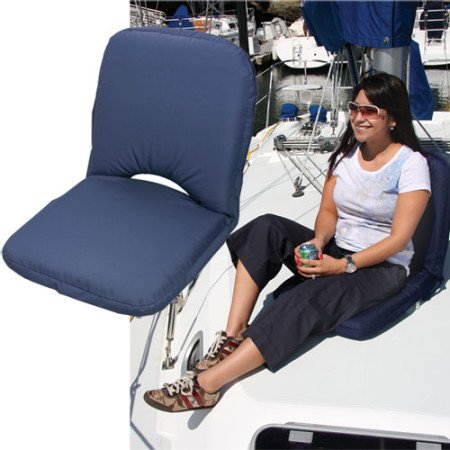
It was a great trip and we met some great people. I tried to keep track of everyone as best I could but I am so bad with names. I jotted down as many as I could as I learned them; here isa sampling some of the people (and boats) we met and spent some time chatting to:
Geoff (from Wales) Welsh Dragon Hunter 320
John Laing Spiritus II Legend 40
Dave and Brett Capricorn Hunter 36
Ian and Linda Passion Hunter 356
Carson & Janet Island Dreamer I Passage 43
Rick and Karine (with a French accent) Lotus Hunter 40
Barry & Kathy Funk (I forgot to write down the boat name…sigh) Hunter 376
The only other thing of note occurred when we met Dave and Brett from Capricorn; they had mentioned that they had initially wanted to look at Rainbow Hunter when it was up for sale. Lawrence had mentioned the first time talked that he had potential buyers “flying in from Ontario” to see the boat. Well it turns out that it was Dave and Brett he had been talking about. Since we snagged Rainbow Hunter right away, they eventually settled on a slightly smaller boat and were now also experiencing their maiden voyages.

Casting off
Sunday morning came around and the docks started emptying in a mass exodus of Hunters. I fired up the diesel with the intention of hitting the gas dock before we left. But when I checked it was occupied and it looked like the big Carver power boat was queued up next. So I headed back to the boat to cast off.
When I got back Lawrence was there and warned me against leaving the boat in idle at such a debris-filled berth. He said that with so much crap in the water it was more likely that something could get sucked into the raw water intake and cause a blockage. His advice was to back it up against the dock and leave it in reverse. That way the prop wash would keep the debris clear. I don’t know if this was prophetic or not but…
As we exited the harbour I started revving up the diesel. All the material that had been left in the boat, indeed even a small label over the tachometer, said not to exceed 2400 rpms. At this point we hadn’t. But I believed, based on my limited reading, that this was too low for a cruising speed. And one of the questions posed to Ben at the diesel seminar had elicited the response that you should run your diesel full-out for a limited period every once in a while, especially if you generally ran it at lower speeds. Cruising speed should then be noted at around 80% of full rpm.
So I ran the engine full out to around 3500 rpm and we started motoring along at a good clip. Right off the bat a puff of blackish smoke came from the exhaust as we blew out some of the carbon accumulation. But, after less than 5 minutes passed, alarms started shrieking. It took me a few seconds, but I finally realized it was the idiot lights on the binnacle (I hate idiot lights), and a few more seconds to equate the alarm with revs and with overheating. I shut down the engine. There was a bit of a breeze, so we hastily unfurled the jib and set a course out into the channel. Then I went down and checked the raw water intake. It seemed like water was coming in and I cleaned the scum from the filter but there were no major obstructions apparent. I fired up the engine again but the alarm was still going. I did note that water was indeed coming from the exhaust though so the intake couldn’t be completely blocked. I shut it down again and called Lawrence’s cell and left a brief message detailing the events. In the worse case scenario there was tons of help just around the corner.
As it turns out we sailed on the jib for about 15 minutes and then tried the diesel again. All good. No alarm and no obvious issues. I called Lawrence and left another message. Then we altered course towards our destination and waited. Another 15 minutes passed and the engine ran fine at 2800 rpm, so since the wind was up, we shut the engine down and raised some sails. It was a great beam reach and we sailed all the way to Ruxton Passage by Decourcey Island. We hit close to 6.5 knots at one point. Our first big sail. W00t!
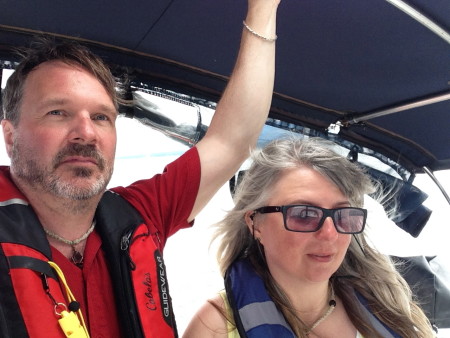
Pirates Cove & Degnen Bay
We stern tied at Pirates Cove for the night. There was a cross breeze so it took some wrestling to get the boat stern in but we managed. Then rowed ashore and hiked a bit in the park there. We also chatted with a few fellow boaters (one couple had also just left the Rendezvous) and enjoyed a nice rain, which was great after the last few days oppressive heat. I like the full enclosure. It makes the cockpit a nice place to hang.

The next morning we called Tim Melville on Gabriola and invited ourselves over. Exiting the cove we tried to sail but the wind just wasn’t there for us and we gave up after about 20 minutes of doing 2 knots. Twenty minutes later we hit Degnen Bay and swung around and there was Tim to help us raft up to Northern Passage on his docks.
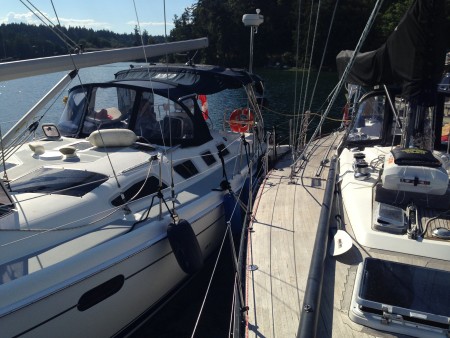
He got a tour of the boat and we chatted about a few of the systems. He even helped me tighten up our stuffing box which was leaking a bit too much. (The stuffing box is the place where the propellor shaft exits the boat. It is meant to leak a little bit to help with lubrication but ours was leaking a bit too much.) Afterwards he headed back up to the house to do some chores and we followed to say hi to Donna. Greetings done and an invitation to dinner extended and accepted, we headed back to the boat to relax for the rest of the day.
I wanted to try the outboard since we hadn’t had an opportunity at Telegraph Harbour so we dropped it down onto the boat using the handy motor hoist and fired it up. Ran great. Leslie and I grabbed our life jackets and went for a tour of the bay.


The 8-horse gets the dinghy up on a plane pretty quickly and top speed it is a bit faster than I am likely to be comfortable with, so it looks like we have a winning combination. Now all we need to do is officially christen her and we are set.
I spent the remainder of the afternoon in the dinghy with my feet dangling in the cool water stripping the vinyl off the starboard side. A couple of hours effort and I finally mastered the technique on the third or fourth last letter. Isn’t that always the way. But I am set if I ever have to do it again.
Dinner was great. A cold Corona and some homemade wine with a spectacular view of the bay. And great company. A nice way to end out trip to the Gulf Islands. Tomorrow we were off through Gabriola Passage on a 9:30 slack and then across the Strait to Vancouver.
Home?
Next morning Tim and Donna came down to see us off and we set out on the last leg of our maiden voyage. The winds were forecast as 0-5 knots so it looked like we were going to be motoring across the Strait. And we did. 4 hours later we motored into English Bay and started manoeuvring through tankers, day sailers and boats heading out.

We were supposed to head (finally) for our berth at Mosquito Creek. We had shelled out over $2000 for the privilege of using it and to this point the boat had never actually occupied its slot. But when I called Lawrence to tell him we were heading there he instead directed me to come back to Granville Island and said he would give us a few days free moorage and move the boat himself later. Turns out he had to rush off to an Xray and couldn’t make it to Mosquito Creek to show us our berth.
So we fuelled up under Granville Bridge and headed for Specialty’s docks. We tied up alongside a new Hunter 36 and that was that. Sarah the service manger came down to finish a talk we had begun back at the Rendezvous and she agreed to check the batteries, wind indicator and AIS system while the boat was still at Granville. And to look into the overheat.
That night we tried out the BBQ on some jumbo dogs and it worked pretty damn good. Then it was packing up and hitting the sack as we had to be at the airport pretty early.
Conclusions
Well all-in-all it was a pretty damn good shakedown cruise. We discovered a few deficiencies, learned a few habits of the boat (although there was never enough sailing time) and had a great time at the Rendezvous. We would do it again if the opportunity arose. But now it is back to Edmonton and work for a few more weeks before the real adventure begins.
